Archaeology's Top 10 Discoveries of 2007
Hardly a week goes by without a major archaeological discovery or the publication of a radical new theory about the human past. Reducing a year's worth of these stories to the 10 most important was a tall order, especially since our intent was to go beyond the headlines and select those we thought made a significant impact on the field--ones that will be talked about for decades. With that in mind, here are our picks for the 2007's most important finds...
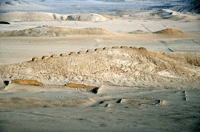
Solar Observatory at Chankillo, Peru Volume 61 Number 1, January/February 2008 by Roger Atwood (Courtesy Ivan Ghezzi)
Travelers have noticed the 13 stone towers rising over Peru's coastal desert since at least the nineteenth century. But researchers only last year discovered the structures' purpose: they make up a sophisticated solar observatory, one of the earliest known in the Americas.
Iv�n Ghezzi of Peru's National Institute of Culture and Clive Ruggles of the University of Leicester showed that the arc of the 13 Towers of Chankillo, built by a still unnamed culture, corresponds almost exactly to the rising and setting sun's range of movement over a year. On the December 15 solstice, for example, the sun would have risen directly over the southernmost tower, when viewed from the west. Wooden lintels embedded in the towers date to about 300 B.C.
Tracking the sun's progress would have helped Chankillo's builders time the planting of their crops. But the towers were probably also meant to express rulers' mystical kinship with the sun, and their ability to influence its movement. "If you were just measuring seasons, there would be no need to make such great structures," says Ghezzi. "The idea was to transmit a political and ideological message about a ruler's close relationship with the sun." An enormous, circular "fortress" near the towers may have played a role in the display.
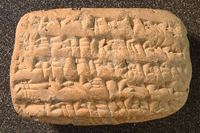
Nebo-Sarsekim Cuneiform Tablet Volume 61 Number 1, January/February 2008 by Laura Sexton
(Courtesy of the Trustees of the British Museum)
Last June, Austrian Assyriologist Michael Jursa was doing what he has done since 1991, poring over the more than 100,000 undeciphered cuneiform tablets in the British Museum. But while analyzing records from the Babylonian city of Sippar, he made a startling discovery with Biblical implications. It came in the unlikely form of a tablet noting a one-and-a-half pound gold donation to a temple made by an official, or "chief eunuch," Nebo-Sarsekim.
"At first I was just pleased to have found a reference to the title 'chief eunuch,' as these officials are mentioned very rarely in the sources," says Jursa. "Then it suddenly came to me that this text was very close chronologically to an episode narrated in Jeremiah 39 in which Nebo-Sarsekim is mentioned, and that I might actually have found the very man. So then I got quite excited and instantly went and checked (and double-checked) the exact spelling of the name in the Hebrew Bible and saw that it matched what I had found in the Babylonian text!"
The tablet is dated 595 B.C., the ninth year of Nebuchadnezzar II's reign. The Book of Jeremiah relates that after Nebuchadnezzar took Jerusalem in 587 B.C., he committed the prophet Jeremiah to Nebo-Sarsekim's care.
"It is so incredibly rare to find people appearing in the Bible, who are not kings, mentioned elsewhere," says Jursa. "Something like this tablet, where we see a person mentioned in the Bible making an everyday payment to the temple in Babylon and quoting the exact date, is quite extraordinary."
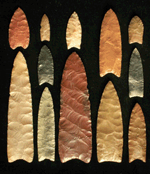
New Dates for Clovis Sites Volume 61 Number 1, January/February 2008 by Mike Toner
(Courtesy Michael Waters)
New radiocarbon dates kept the controversy over the peopling of the Americas simmering in 2007. An analysis of dates for the best-documented Clovis sites suggests the culture arose later and was shorter-lived than once thought, a finding that some say deals a blow to the "Clovis first" theories that maintain the big-game-hunting people were the first immigrants to the New World. Michael Waters, director of the Center for the Study of the First Americans, and Thomas Stafford of Stafford Research Laboratories in Colorado, used modern radiocarbon methods to re-date more than 20 previously known Clovis sites which had been dated with older, less precise techniques. All of the sites now seem to fall between 13,050 to 12,800 years ago. Most archaeologists still believe the Clovis people inhabited North America for at least 500 years, starting about 13,300 years ago.
Waters and Stafford contend this new 250-year window for Clovis in America is too brief for any founding population of hunter-gatherers to have dispersed across the Americas. Instead, they argue, such tightly spaced dates reflect the spread of Clovis technology and its signature fluted points through a preexisting population. But in a letter to Science, more than a dozen prominent archaeologists, including some who are open to the notion of a pre-Clovis culture in the Americas, insist there is no basis for Waters and Stafford's theory that technology may have spread more swiftly across the continent than humans themselves. What's really needed, they say, is more rigorous dating of all Paleolithic sites in the Americas.
"We'll be happy to date any Clovis site anyone wants," says Waters. "But the idea that Clovis was first just doesn't make any sense. Unless they had a time machine, there isn't any way for them to have spread across two continents that fast."
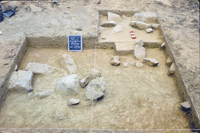
Early Squash Seeds, Peru Volume 61 Number 1, January/February 2008 by Samir S. Patel (Courtesy Tom Dillehay)
New research favors the idea that agriculture began in the New World shortly after it first appeared in the Old World. Tom Dillehay of Vanderbilt University has the squash seeds to prove it.)
Found in buried house floors in the northern Andean �anchoc Valley, the seeds were discovered near other floral remains, including peanut shells, quinoa grains, and cotton bolls, as well as stone hoes, grinding stones, plots for planting, and small-scale canals for irrigation. With accelerated mass spectrometry, Dillehay's team dated the remains to between 6,000 and 10,000 years ago, with the 10,000-year-old cultivated squash seeds being the oldest. Similarly old evidence of other species of squash has also been found in Mexico and Ecuador. )
Across the world, in the Fertile Crescent, the domestication of rye, wheat, and barley between 12,000 and 10,000 years ago helped mark the transition from nomadic lifestyles to sedentary agricultural communities that would lead to more complex societies. Plant cultivation appears to have played a similarly central role in the tropical dry forest of the �anchoc Valley. Over several thousand years, the people settled down, planted more, managed their water supply, and built ritual mounds--steps toward the more advanced Andean cultures to come. According to Dillehay, "Not only do people domesticate plants, but the plants in some ways domesticate people."
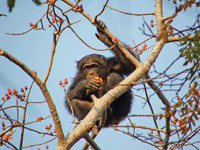
Ancient Chimpanzee Tool Use Volume 61 Number 1, January/February 2008 by Zach Zorich (Courtesy Paco Bertolani)
Archaeologists led by Julio Mercader of the University of Calgary have uncovered the first known ancient chimpanzee archaeological site, a grouping of stone hammers that were used by apes 4,300 years ago to smash open nuts. By analyzing pollen grains embedded in the stones, the team was able to identify five species of nuts the tools were used to open, four of which are not eaten by humans. The discovery shows that stone tool use is not a behavior that chimpanzees learned recently by watching the farmers who live in the area, as some skeptics believe. Mercader thinks that humans and chimpanzees may have inherited stone tool use from an ancestral species of ape that lived as long as 14 million years ago.
Although using a big rock to smash open a nut may seem like a simple task, Mercader sees the stones as clues to much more complex behavior. "There is clear evidence that chimpanzees understand what raw materials they need," he says, pointing out that the apes prefer specific, durable types of stone, such as quartzite or granite. Knowing where to find the stones also requires planning and a good memory in a thick jungle where visibility is only about 40 feet.
The number of behaviors that are uniquely human has been steadily dwindling as scientists learn more about our primate cousins, but producing cutting tools still seems to be beyond the abilities of chimpanzees living in the wild.
"If you go to a nut-cracking site today, you would find there are flakes that come off of the hammers," Mercader says. "What we haven't seen is a chimp picking up any of those by-products and using them."
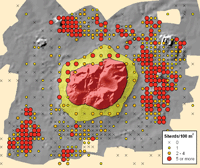
Urbanization at Tell Brak, Syria Volume 61 Number 1, January/February 2008 by Heather Pringle
(Courtesy Jason Ur)
Archaeologists have long believed that the world's oldest cities lay along the fertile riverbanks of southern Mesopotamia, in what is now Iraq. There, in a land of plenty, went the idea, powerful kings began coercing their subjects to live together some 6,000 years ago. Their great invention--the city--later spread throughout the Near East. But last August, Harvard University archaeologist Jason Ur and two British colleagues turned that idea on its head. Their intensive field survey and surface collection of potsherds at the site of Tell Brak in northern Syria revealed that an ancient city rose there at exactly the same time as urban centers first sprouted up in southern Mesopotamia, but followed a very different model of development. "Urbanism," says Ur, "is not one brilliant idea that occurred one place and then diffused."
Tell Brak first came to scientific attention in the 1930s when British archaeologist Max Mallowan and his wife Agatha Christie started excavations there. But recently, a team led by Cambridge University archaeologist Joan Oates has unearthed new clues to the city's early years. By 3900 B.C., the ancient metropolis sprawled across some 130 acres and boasted a flourishing bureaucracy and skilled artisans turning out fine marble chalices and other luxury goods for the ruling class.
Intriguingly, Tell Brak seems to have grown from the outside in. In the south, cities began as a central settlement--under a single authority--that grew outward. But Ur's field survey shows that Tell Brak started as a central community ringed by smaller satellite settlements that expanded inward. "There isn't a very tight control over these surrounding villages, at least at this beginning period," says Ur. "So the assumption that we're making is that people were coming in under their own volition."
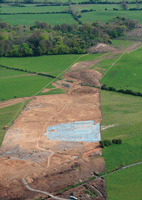
Lismullin Henge, Tara, Ireland Volume 61 Number 1, January/February 2008 by Jarrett A. Lobell
(Courtesy Paula Geraghty/Save Tara Campaign)
Early last year, archaeologists working on the route of a controversial highway near the village of Lismullin, Ireland, stumbled across a vast Iron Age ceremonial enclosure, or henge, surrounded by two concentric walls. The 2,000-year-old site is just over a mile from the Hill of Tara, traditional seat of the ancient Irish kings and site of St. Patrick's conversion of the Irish to Christianity in the fifth century A.D. The discovery of the massive henge, measuring more than 260 feet in diameter, confirms the long-held belief that the area around the hill contains a rich complex of monuments.
The extraordinary amount of archaeological remains on the Hill of Tara--burial mounds, religious enclosures, stone structures, and rock art dating from the third millennium b.c. to the twelfth century A.D.--makes it Ireland's most spiritually and archaeologically significant site. Construction of the new M3 highway, meant to ease traffic congestion around Dublin, threatens not only the Hill of Tara's timeless quality, but also newly discovered archaeological sites in the surrounding valley.
Lismullin, seen at right in an aerial shot taken during excavations, and other sites that stand in the way of the new road are now approved for destruction. Although archaeologists and concerned Irish politicians are rallying support worldwide for the protection of the Hill of Tara (see
www.savetara.com to learn more about the effort), the iconic site remains in great peril. At press time, the European Commission had initiated legal action against the Irish government over the M3, charging Ireland with failing to protect its own heritage.
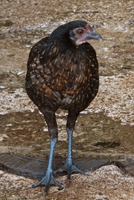
Polynesian Chickens in Chile Volume 61 Number 1, January/February 2008 by Eric A. Powell
(Chicken: Anita Gould, Bone: Courtesy Alice Storey)
Scholars have long assumed the Spaniards first introduced chickens to the New World along with horses, pigs, and cattle. But now radiocarbon dating and DNA analysis of a chicken bone excavated from a site in Chile suggest Polynesians in oceangoing canoes brought chickens to the west coast of South America well before Europe's "Age of Discovery."
An international team, including bioarchaeologist Alice Storey of the University of Auckland, made the startling discovery after analyzing a recently excavated chicken bone from the Chilean site of El Arenal, a settlement of the Mapuche, a people who lived on the southern fringe of the Inca empire from about A.D. 1000 to 1500.
The team found that the chicken's DNA sequence was related to that of chickens whose remains were unearthed from archaeological sites on the Polynesian islands of Tonga and American Samoa. Radiocarbon dating shows the El Arenal chicken lived sometime between a.d. 1321 and 1407, well after Polynesians first settled Easter Island and the other easternmost islands of the Pacific.
In 1532, Spanish conquistador Francisco Pizarro recorded the presence of chickens in Peru, where the Inca used them in religious ceremonies. "That suggests chickens had already been there for a while," says Storey. "It's possible there are stylized chickens in the iconography that we have not recognized because we did not know they were there. I'm fascinated to see what [archaeologists] are going to do with this information."
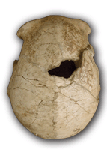
Homo habilis & Homo erectus Volume 61 Number 1, January/February 2008 by Zach Zorich
Whether they are mother-and-daughter species or two sisters, the relationship between Homo habilis and Homo erectus is becoming strained. A pair of discoveries near Lake Ileret in Kenya call into question the idea that H. erectus, the species from which modern humans evolved, is descended from H. habilis, the earliest hominid known to use stone tools.
A team of paleoanthropologists led by Meave and Louise Leakey of the Koobi Fora Research Project uncovered the upper jawbone of a H. habilis dated to 1.44 million years ago, and the skull of a H. erectus dated to 1.55 million years ago. H. habilis was thought to have gradually evolved into H. erectus over hundreds of thousands of years, fading out of existence around 1.65 million years ago. A previously discovered H. erectus fossil dated to 1.9 million years combined with the new finds show the two species lived together in the same lake basin for close to 500,000 years.
The discovery of a Homo habilis jawbone and a Homo erectus skull that are close in age has paleontologists rethinking the idea that H. habilis evolved into H. erectus. (National Museums of Kenya/Fred Spoor)
"I think increasingly they will be recognized as sister species that lived in the same area and did different things," says Fred Spoor of University College London and a member of the team. H. erectus' smaller teeth and less powerful jaws suggest it was probably eating more meat. If the two species both evolved from a common ancestor, it changes the human race's relationship to H. habilis. "Strictly speaking, if our scenario is correct," says Spoor, "Homo habilis, as we know the species, seems to be a dead branch."
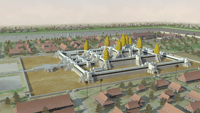
Greater Angkor, Cambodia Volume 61 Number 1, January/February 2008 by Karen Coates
(Courtesy Tom Chandler/Monash University)
The capital of a Khmer state that flourished between the ninth and fifteenth centuries, Cambodia's Angkor is one of the most intensively studied sites in the world. But it continues to inspire more questions than answers, the most fundamental being why the sophisticated Khmer Empire collapsed. In 2007, research into the mysteries of the world's largest preindustrial city reached a milestone with the completion of a 10-year mapping project, which yielded clues suggesting that the sprawling metropolis may have collapsed under self-induced environmental pressures related to overpopulation and deforestation.
"Angkor was a vast inhabited landscape...larger than anything previously known," says Damian Evans, deputy director of the Greater Angkor Project (GAP) and lead author of the group's findings. Their map covers more than 1,100 square miles, detailing thousands of features that were part of an elaborate irrigation system.
The GAP team combined previously existing ground surveys, aerial photos, and radar remote-sensing data provided by NASA's Jet Propulsion Lab to create the comprehensive map. It shows an urban center surrounded by dispersed agricultural villages, local temples, and small reservoirs. The team found evidence of silted canals and breached waterworks that suggest the people of Angkor were eventually unable to maintain the vast irrigation system because of erosion and increased flooding. The map also shows the metropolis extended miles beyond the ruins within today's Angkor Archaeological Park. "Extremely valuable archaeological material stretches far beyond the World Heritage zone," Evans says.
Source
What would you have picked as the year's most important find, whether it's something we picked or something we missed, rounding out the year's 20 most important discoveries?



